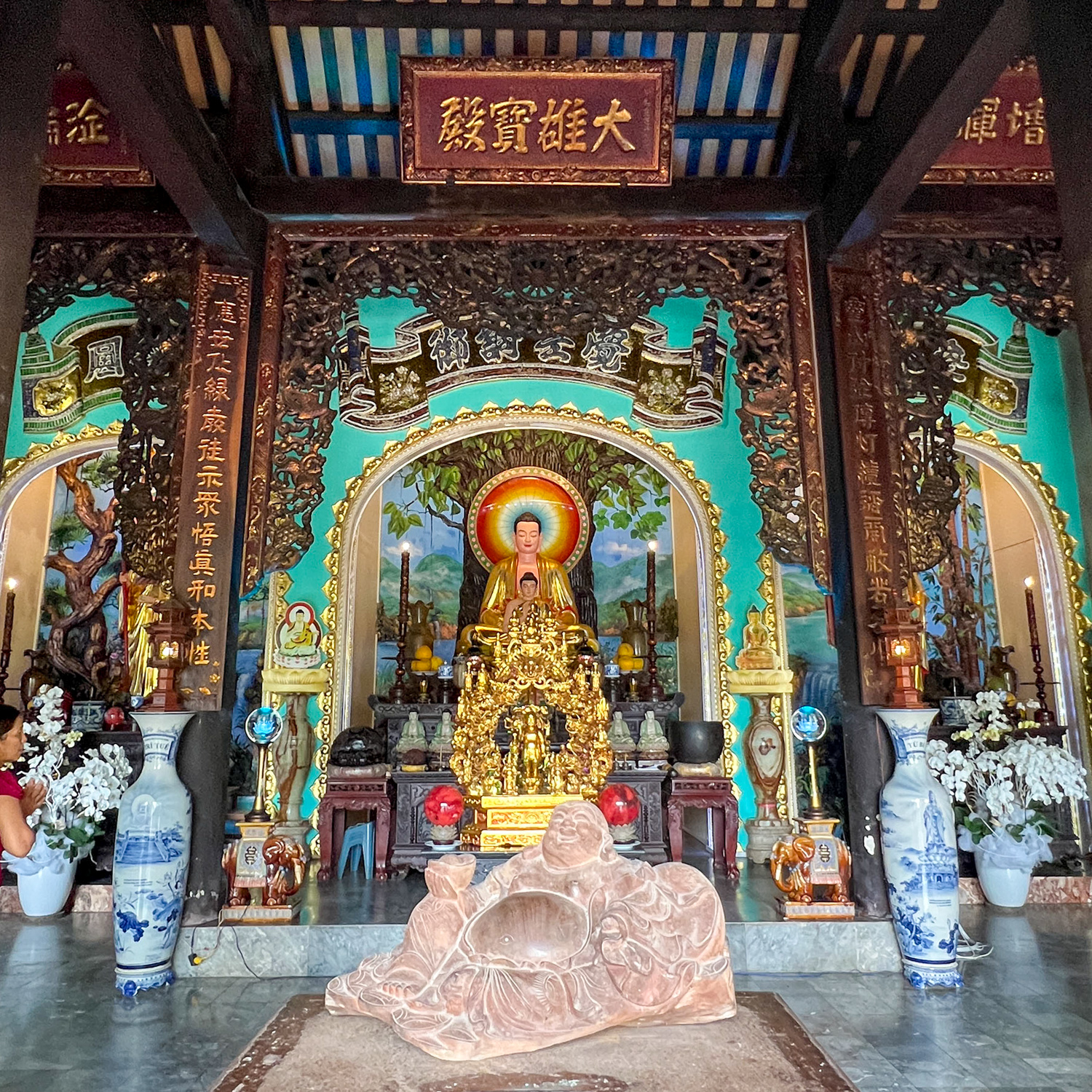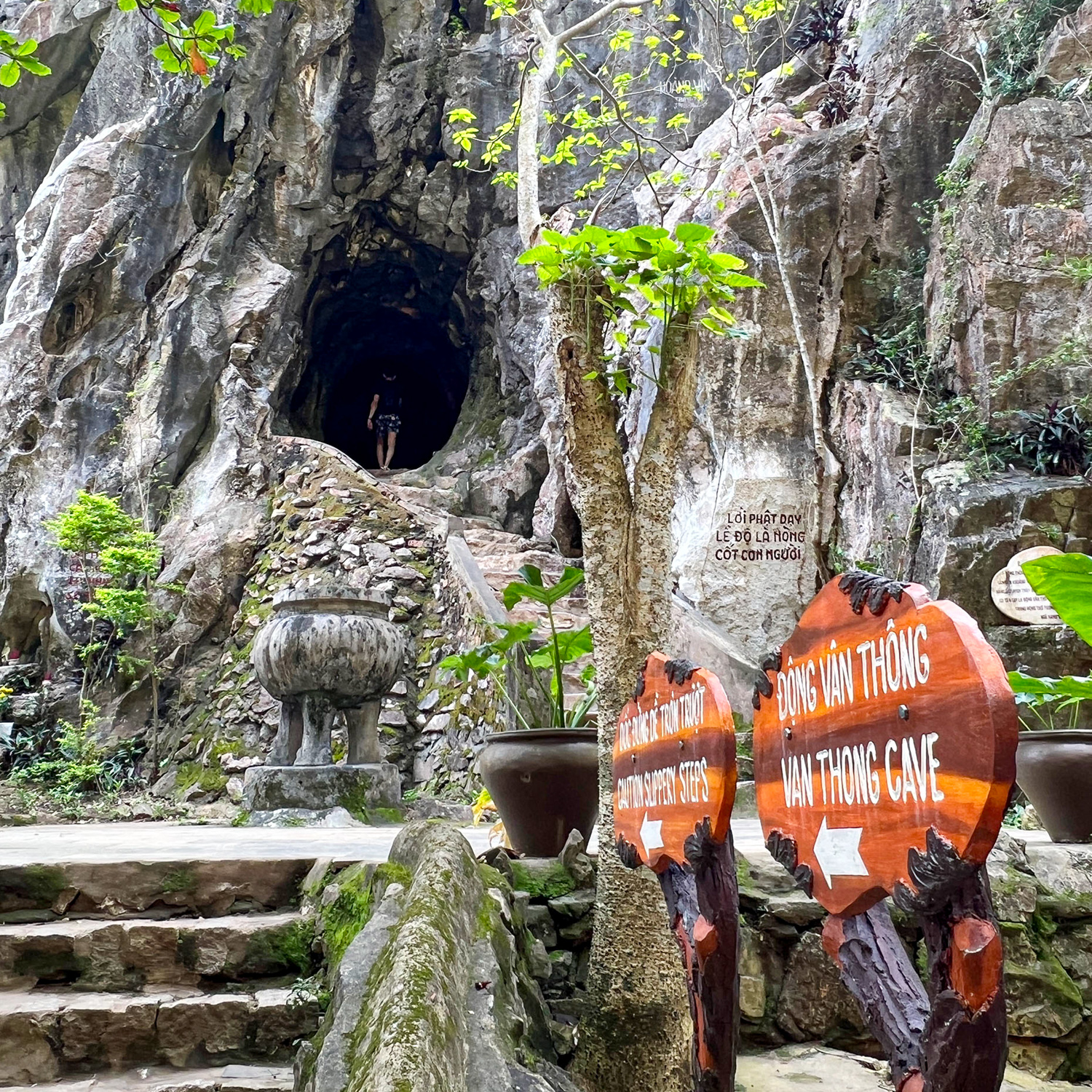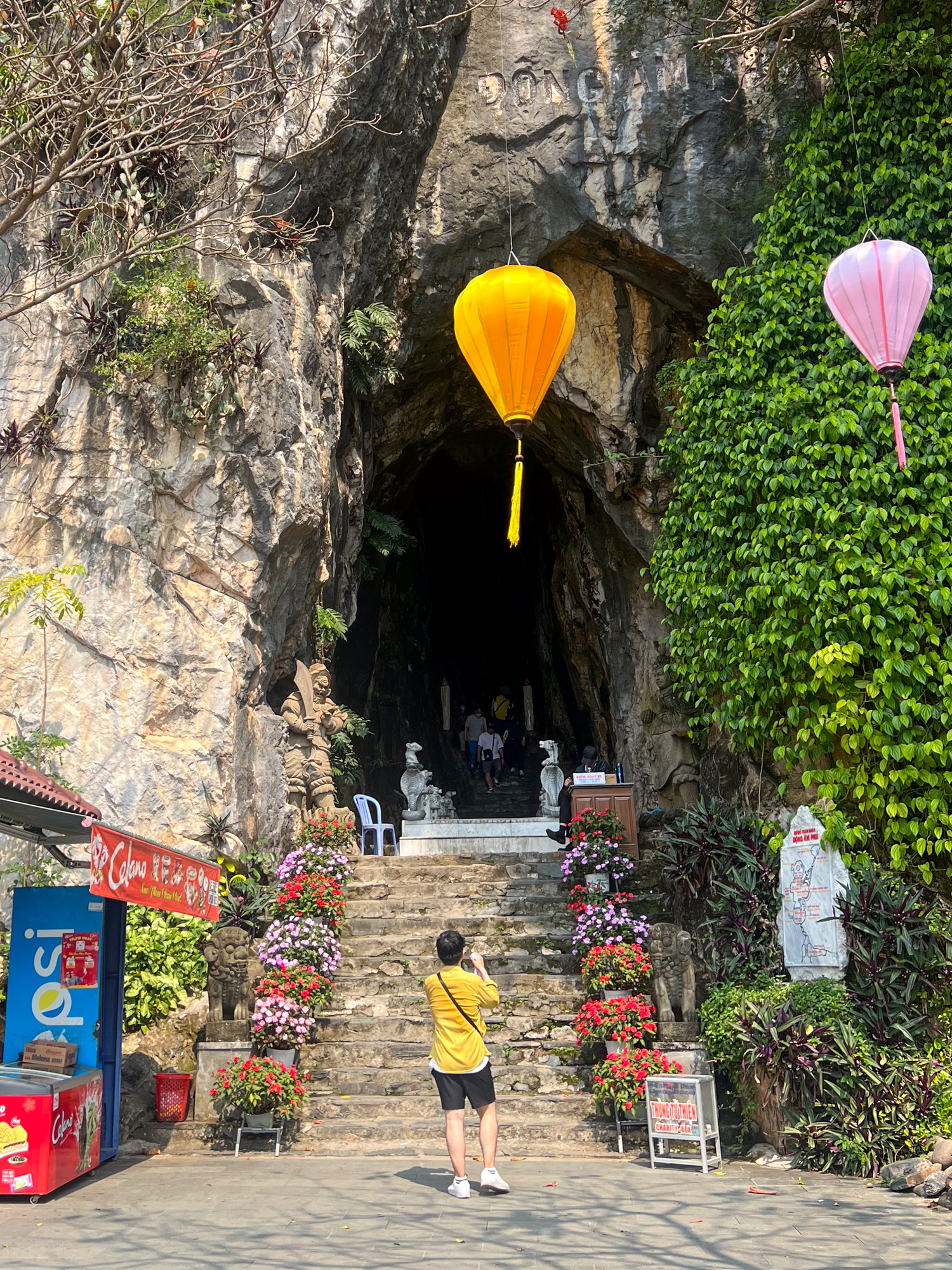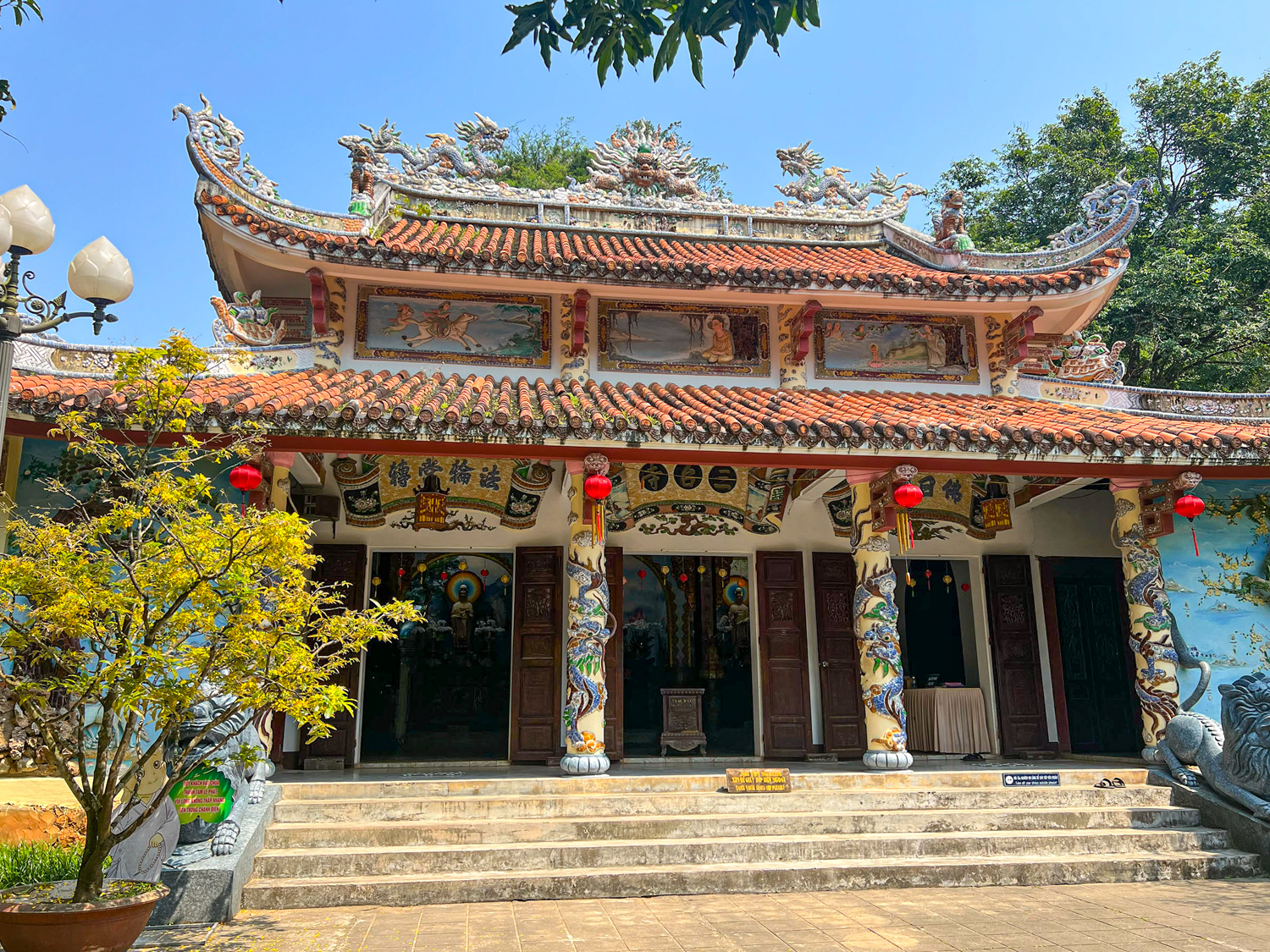On the coastal plain near Da Nang, five marble and limestone mountains disrupt the flat landscape. The Marble Mountains are not the most majestic in Vietnam or, for that matter, the largest.
But they indeed have an ethereal air to them. For one, they're a strange sight—five tree-covered rocky hills rising in juxtaposition to the flat countryside and nearby South China Sea.
They've also been a spiritual haven for centuries, a holy place to wander and appreciate.

Table of Contents
Spiritual History
The Marble Mountains are steeped in spiritual and mystical legend.
The Cham people, who lived in central and Southern Vietnam from the 2nd to the 17th century, believed the limestone and marble hills were sacred sites, especially the caves and tunnels running through the porous limestone.
According to Cham legend, a giant dragon gave birth to the mountains. From the sea, the great creature flew over the land, laying her eggs. They hatched into the enchanting mountains we see today.
Another version of the tale says the mountains emerged from the eggshell fragments.
Whether you believe they are a gift from Mother Nature or a mythical dragon, the Marble Mountains have always held spiritual significance in Vietnam.
The Cham worshipped there for centuries, converting many caves into Hindu sanctuaries.
After the fall of the Cham empire, the Buddhists took over, adding the temples and pagodas we see today. Some are more than 400 years old.

The mountains were named in 1825 by Minh Mang, the second emperor of the Nguyen Dynasty.
Named Ngu Hanh Son, the Five Elements Mountains, each peak refers to one of the five essential elements of Eastern philosophy:
- Kim (metal) – Metal Mountain
- Moc (wood) – Wood Mountain
- Hoa (fire) – Fire Mountain
- Tho (earth) – Earth Mountain
- Thuy (water) – Water Mountain
But it was during the French Colonial period that French geologists dubbed the peaks the “Marble Mountains” after learning their composition.
Red, white, and green marble was once quarried from the mountains, but all mining has ceased to keep the structural integrity.
Now, the area is a massive tourist draw. While all the mountains have caves and tunnels, Mount Thuy is the only one open to visitors.
Thuy Son Mountain

Mount Thuy, also called Thuy Son Mountain or the Water Mountain, is a spectacular and surreal place to visit.
Buddhist statues and shrines line the inside of the caves; pagodas, gates, and towers stand above ground.
Breathtaking, sweeping views await at the top of the mountain, and you'll undoubtedly be out of breath to get there.
Visitors must endure the 156 stone steps unless they opt for the glass elevator that cuts out about two-thirds of the climbing.

Part of our group initially chose the elevator at the base of the mountain but quickly changed their mind after observing the long line. There's also an additional elevator fee, so know what your entrance ticket includes.
Be prepared to get your Stairmaster workout in. There are several other stairs at other points on the mountain, some in the open areas, others in the depth of the caves.
The grotto stairs, which can be slippery, show their wear from the centuries of people trekking over them.
Carved Beauty

Climbing the steep, winding stairs, we were greeted near the top by an intricately carved, multi-headed marble dragon.
It's the first hint of the elaborate carvings and rich details at the pagodas and inside the caves of the Marble Mountains in Vietnam.

Above Linh Ung Pagoda, built in 1825, a giant seated Buddha statue anchors a small fish pond, surrounded by more carvings and a beautiful garden.
Nearby, the Lady Buddha pavilion, the seven-story Xa Loi Tower, and the main hall adorned with carved roof dragons make for engaging photos.
Tang Chon Cave
Past the pagoda is the first cave encounter, Tang Chon. Wide expanses of open ceilings and smaller holes send shafts of light through the Tang Chon Cave, creating a natural ambiance, unlike any cave I've experienced.

It's a stunning, ethereal experience, especially at the stone shrine built into a massive alcove which took on a gauzy, dreamy feel.
Various tunnels lead to other nooks with statues and marble sculptures of all sizes. We looked in reverence at one altar with a giant carved Buddha statue towering over us.

Natural light casts down on a delightful scene in another grotto: stone sculptures of two seated men playing chess.

We continued exploring, climbing the worn steps leading us up and around the mountain. In open plateaus, visitors pass through openings in the rock to travel farther on the path.
Along the way, we observed the steep and massive rocky edifices surrounding us, greenery and tree roots draped over the edges and down the rocks. It was reminiscent of the upside-down floating mountains in Avatar.
Van Thong Cave
There are five other caves to explore, including Van Thong Cave, which has a tempting but challenging tunnel behind the main cave with its standing Buddha statue.
A few of us scurried up the steep steps to find a small grotto with streaming light filtering down to the rocky floor.


At the back of this cave, a narrow, rugged path takes you to the top of the cave. Outside, a rocky path leads to one of the mountain's peaks and sweeping views.
Van Thong is called the Heaven Cave, and this high, challenging climb takes you to the “heaven gate” with a view of Da Nang's beaches and mountains in the distance.
Huyen Khong Cave
Huyen Khong Cave is the largest and most magnificent cavern at Mount Thuy. It has several small temples and ample space for walking around.
A seated Buddha looks out over the cave from an elevated crevice up high. Sunlight streams through several openings, creating gorgeous shafts of light.
Am Ph Cave

Known as the hell cave, Am Ph is accessible from the foot of the mountain, near the elevator. Animal statues guard the entrance to this massive cavern, flanked out front by matching python sculptures.
Inside are several statues alluding to the Last Judgement, a religious reference to a soul's journey after death.
The Oldest Pagoda

On the way to the other pagodas, there are several gates to walk through. They offer more examples of stunning ancient architecture among the tropical canopies.
The shade from the banyan trees provides a nice respite from the heat. Thankfully, several vendors in the relaxation area have set up along the pathway, selling water, fresh coconuts, and cold treats.
Tam Thai Pagoda is the oldest holy site on the mountain, built in the 17th century. Although rebuilt and restored many times, the 400-year-old pagoda retains a majestic feel.

Like Linh Ung Pagoda, it has a tile roof and marble creatures on top. A seated, laughing Buddha sculpture greets visitors in the courtyard.
The stone gate into the pagoda is a three-door structure, weathered by centuries. It's quite the stately entrance into the sacred landmark.
The Views
There are several spots for panoramic views of the landscape. To the right of the relaxation area is Dinh Thuong Thai, the highest peak on the mountain.
It'll take some climbing to get there, but you'll have spectacular views of Da Nang's beaches, such as Non Nuoc Beach to the south and the other Marble Mountains in Vietnam.

Near Tam Thai Pagoda is Dai Vong Giang, another viewpoint. We climbed the steps to a small gazebo for a closer, better view of the Marble Mountains.
Each is a different shape, the rocky limestone covered with trees, jutting up from the flat coastal plains.
Additional Notes
Thuy Son Mountain is a spiritual destination and home for Buddhist monks. Part of the magic of wandering the site is observing the monks pass by, saying prayers, and performing rituals in the Buddhist temples.
It's also a place for pilgrimage for other visitors. Tourists should remain respectful, not disturbing those on spiritual journeys.
As a religious site, visitors should dress conservatively. Also, with the number of steps and walking, athletic shoes are the best footwear option.

The best time to visit is early morning to avoid the largest crowds and afternoon heat. If possible, avoid the rainy season from August to December.
At the foot of the mountain is Non Nuoc village with plenty of marble craftsman shops. The fine arts village has been there for more than 300 years.
Although the stone is no longer sourced from the Marble Mountains, most of the statues and carvings are from quarries in Vietnam.
There's also a host of local people selling hats, purses, and other textiles. We walked past the crowded marketplace to reach the mountain entrance and stumbled onto several more shops on our exit.
Vendors can be a bit pushy, but there are great opportunities for cheap but quality souvenirs.
How To See Marble Mountains

Mount Thuy is minutes from the center of Da Nang City along the main beach highway, Vo Nguyen Giap.
Taxis and Grab (Vietnam's Uber) are easy to hail from the coastal city. You can also opt for bus or motorbike transportation, although you'll have to pay to park a scooter.
Group day trips and private tours are a way to avoid transportation planning and combine a day trip to the Marble Mountains with other destinations in Central Vietnam.
You could spend all day on the mountain, but we recommend a half day so you can see other popular tourist destinations like the Golden Bridge, My Son Sanctuary, and the ancient town of Hoi An.
The entrance fee to the mountain is 40,000 VND, or about $2 (USD). Note the elevator is an additional cost, and Am Phu Cave can be purchased separately.
Planning a trip? Go Backpacking recommends:
- G Adventures for small group tours.
- Hostelworld for booking hostels.
